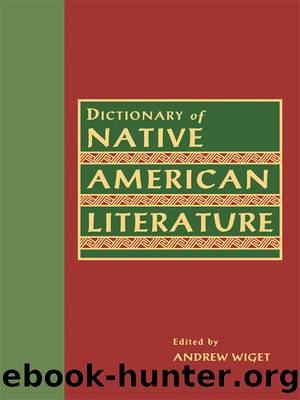Dictionary of Native American Literature by Wiget Andrew

Author:Wiget, Andrew. [ANDREW WIGET]
Language: eng
Format: epub
Publisher: Taylor & Francis (CAM)
Published: 2011-10-19T16:00:00+00:00
BIBLIOGRAPHY
Oskison, John Milton. Wild Harvest. New York: Appleton, 1925.
——. Black Jack Davy. New York: Appleton, 1926.
——. A Texas Titan.New York: Doubleday, 1929.
——. Brothers Three. New York: Macmillan, 1935.
——. Tecumseh and His Times. New York: G.P.Putnam, 1938.
——.“Autobiography.” Unpublished manuscript. 1947. Western History Collection, U of Oklahoma Library, Norman.
Simon Pokagon (1830–January 1899)
Simon Pokagon was the youngest son of Chief Leopold, who was chief of the Pokagon band for over forty years. Although the band was primarily located near South Bend, Indiana, its original territory encompassed presentday Chicago. During the late 1830s, they settled near Dowagiac, Michigan. In 1844, Pokagon enrolled at Notre Dame, probably at the university’s manual labor school, where he spent three years. Pokagon subsequently studied for two years at Twinsburg Institute, near Cleveland, Ohio, which prepared students for college (Dickason 1971: 136–39). Although Pokagon’s admirers frequently called him the best-educated Indian in America, he did not attend college, as was often asserted.
Pokagon surfaced as a public figure in 1864, when he went to Washington as a member of the Potawatomi delegation that persuaded the Secretary of the Interior to pay back annuities. Never a principal chief, Pokagon did serve for several years as chair of the band’s Business Committee. He aroused considerable anger among his band because in 1881 he sold for cash, without the consent of the band, discounted notes that were supposedly guaranteed by anticipated settlements of Potawatomi claims, and because in 1894 he established a rival, unauthorized Business Committee to pursue his own settlement claims. In 1895, the Potawatomi rejected his claims, petitioning the Commissioner to refuse him any special status or funds. Still energetic in the pursuit of his own cause, Pokagon in 1897, purportedly acting on behalf of the whole band but without their knowledge or consent, sold by quitclaim the band’s whole interest in the Chicago lakefront (Clifton, The Pokagons, 86–87, 97, 103–4, 112–13). During these years, Pokagon’s campaign to gain public support for his claims, his many speeches to whites as a spokesman for Indian causes, and his appearance as part of the 1893 Columbian Exposition in Chicago gained him considerable popularity among whites. Greatly lionized by the press during this period, Pokagon was inaccurately credited by a Chicago reporter for obtaining the 1896 settlement of Potawatomi claims (Clifton, The Pokagons, 107).
Although Pokagon has been credited with writing O-gî-mäw-kwe Miti-gwä-kî (Queen of the Woods), the first American Indian novel devoted to Indian life, his authorship is currently questioned. Queen of the Woods, which may have been ghostwritten by Mrs. Cyrus H. Engle, was published after Pokagon’s death by Engle. Its Victorian diction differs considerably from the broken English
Pokagon used in his letters. This highly sentimental romance contrasts the idyllic forest life led by the Potawatomi with the destructive forces introduced by the white man. Engle indicates in the preface that “nearly all the persons mentioned in the narrative bear their real names, and were personally known to many yet living” (i). Pokagon, who is the narrator, uses his wife’s name, Lonidaw, for the female protagonist and includes some details of their backgrounds.
Download
This site does not store any files on its server. We only index and link to content provided by other sites. Please contact the content providers to delete copyright contents if any and email us, we'll remove relevant links or contents immediately.
4 3 2 1: A Novel by Paul Auster(11792)
The handmaid's tale by Margaret Atwood(7450)
Giovanni's Room by James Baldwin(6810)
Asking the Right Questions: A Guide to Critical Thinking by M. Neil Browne & Stuart M. Keeley(5357)
Big Magic: Creative Living Beyond Fear by Elizabeth Gilbert(5354)
Ego Is the Enemy by Ryan Holiday(4958)
On Writing A Memoir of the Craft by Stephen King(4664)
The Body: A Guide for Occupants by Bill Bryson(4585)
Ken Follett - World without end by Ken Follett(4444)
Bluets by Maggie Nelson(4262)
Adulting by Kelly Williams Brown(4235)
Eat That Frog! by Brian Tracy(4149)
Guilty Pleasures by Laurell K Hamilton(4118)
White Noise - A Novel by Don DeLillo(3829)
The Poetry of Pablo Neruda by Pablo Neruda(3816)
Fingerprints of the Gods by Graham Hancock(3738)
Alive: The Story of the Andes Survivors by Piers Paul Read(3731)
The Book of Joy by Dalai Lama(3698)
The Bookshop by Penelope Fitzgerald(3619)
